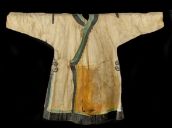Copper hangers
Walk and you hear a tinkle: something is at the end of the robe. These metal ornaments that are attached to the hem of the robe are called vec. They are precious objects passed down from mother to daughter and they are what differentiates a woman’s robe from a man’s robe. This may just be something of the Amur Nivkh, as ethnographer and linguist Taksami reports that Sakhalin Nivkh women do not sew ornaments onto the hem of their robes. Von Schrenck also provides information on these ornaments:
The undershirt and dress most often have a broad hem of differently colored fabric. Along the fabric of the dress run one or a couple of rows of Chinese-made brass plates of various forms or those well-known Chinese copper coins fashioned with a square hole, as jewellery hanging from small straps. As a result of this, any step taken by the women is accompanied by the clang of these aforementioned plates or coins banging together.
The fact that Von Schrenck identifies Chinese coins among the ornaments is significant. The type of coins he describes is known as jiha in Manchu. This word is the origin of the Nivkh word cxha meaning ‘coin’. The Nivkh, as well as the Ulch, were the intermediaries in a trade network between China and Japan, which was a highly profitable position. The fact that the word for ‘coin’ originates from Manchu further attests to these historical trade relations that existed between the Nivkh and China.
The other peoples of the Amur also used these types of ornaments. For example, the Manchu text describing the Heje people gives the following account of their fish skin robes:
As for the clothes, they make them with fish skin, decorating them with colorful cloth and small copper bells are hung from the hem. The clothing resembles armor very much.
The real pièce de résistance of this curk is on its back. Perhaps you should get a mirror (or just click).




